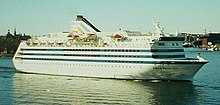Baltic Sea cruiseferries
Viking Line and Eckerölinjen also operate short routes from Sweden to Åland, sailing on Kapellskär - Mariehamn and Grisslehamn - Berghamn.
The size of Baltic cruiseferries is limited by various narrow passages in the Stockholm, Ålandian and Turku archipelagos, meaning ships that traffic these routes can't be much larger than 200 meters.
The longest ships to maintain scheduled service through the Kustaanmiekka strait were MS Finnstar and her sisters with a length of 219 meters.
The longest ship to have ever navigated through the narrows past Suomenlinna sea fortress was MS Oriana (260 m), but that was only possible due to extremely good weather conditions.
The expansion of the European Union has limited the growth of the industry as duty-free sales on intra-EU routes are no longer possible.
However, as Åland is outside the EU customs zone, duty-free sales are still possible on routes making a stop at Mariehamn or other harbours on the islands.
The ferries have been criticized because of the low prices of alcoholic beverages which encourage passengers to become drunk and act irresponsibly.
Travelling by cruiseferry has been a significant experience for many middle-aged Finns from their childhood and youth, exciting and a little bit sinful.
[11][12] According to journalist Riku Rantala, a cruiseferry trip is still a manifestation of Finnish culture, like a part of modern folklore: "The ferries offer escapism, glamour and a promise of adventure".
A group of shipping companies having cooperated for decades, the Finnish Bore and SHO-FÅA (later Effoa) and the Swedish Rederi AB Svea found each other in this regard too and founded a joint company named Oy Siljavarustamo - Ab Siljarederiet in 1957 to handle the ferry traffic.
[16] In 1964 Slite received the recently completed car ferry MS Apollo, with its red-painted sides bearing the marketing name Ålandspilen, meaning "the Åland Arrow" in Swedish.
The fourth cruiseferry company was Ålandsfärjan founded in 1963, with its first namesake ferry having been converted from the 1933 ship SS Brittany trafficking over the English Channel.
The newspaper Helsingin Sanomat described the elbow tactics of deck passengers on fully-booked night trips on cruiseferries.
[22] Off-season, the ferries attracted passengers by even offering deck tickets for free to spend money on board on tax-free shopping and restaurant services.
[24] Along with the cruiseferries, Swedish people also started to get interested about visiting continental Finland, but especially about short alcohol-infused pleasure trips to the Åland islands and back.
[27] When the main selling point of the cruiseferries in the 1960s was fast and cheap passage over the sea, this was overshadowed by relaxed entertainment on board in the 1970s.
[34] The selection of services also grew, and the ferries became popular entertainment centres, competing more with spa hotels than with other ways of travel across the sea, with swimming pool departments and visit by top artists.
One of the companies within the Viking group, Rederi Ab Sally, had gone under Silja Line's ownership because of financial difficulties in 1987.
[16] After Finland and Sweden had joined the European Union the countries had to fit in with the prohibition of tax-free sales of alcohol and tobacco products in intra-EU transport in early July 1999.
[36] In practice, this meant that all cruiseferries between Finland and Sweden have since made a quick stop at Åland to fulfil the condition of the edict.
[37] Ferries on the Turku-Stockholm and Naantali-Kapellskär routes started using the Långnäs harbour in Lumparland on 1 July 1999, which had previously been in passenger ship use in the middle 1970s and was now reopened after renovation.
Maritime professor Jorma Taina has estimated that the "huge hotel department stores" on the Helsinki-Stockholm route had come to the end of their life and saw the future of the Baltic Sea transport in the ropax ships that were more modest than the cruiseferries and combined passenger cabins with effective cargo spaces.
[39] In addition to Tallink and Viking Line, Finnlines also started to concentrate on ropax ships, of which it ordered five from the Italian shipyard Fincantieri and deployed some of them on the route from Finland to Sweden.
This created a need for other kinds of ships than cruiseferries along the different-length routes on the Baltic Sea, especially after tax-free sales had ended at the turn of the millennium.
[48] The Baltic Sea cruiseferries and travel on them are a multi-faceted phenomenon of life, which has received diverse criticism, mostly because of environmental reasons.








